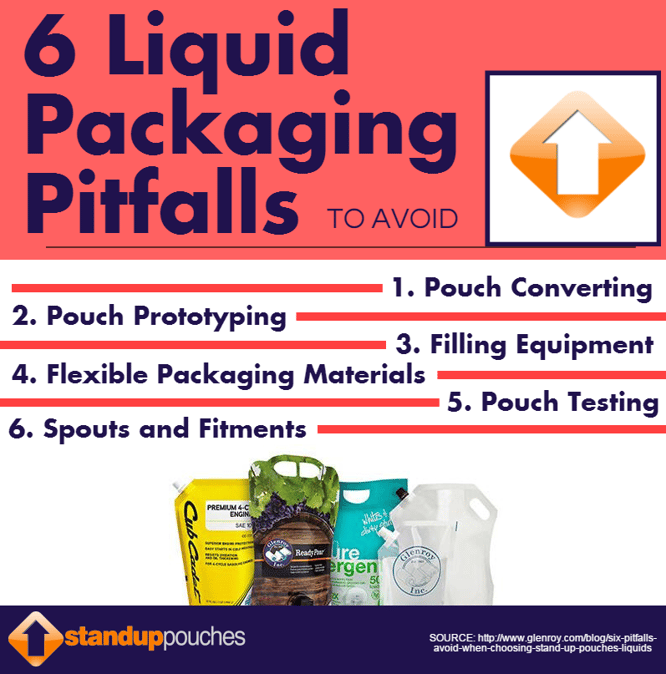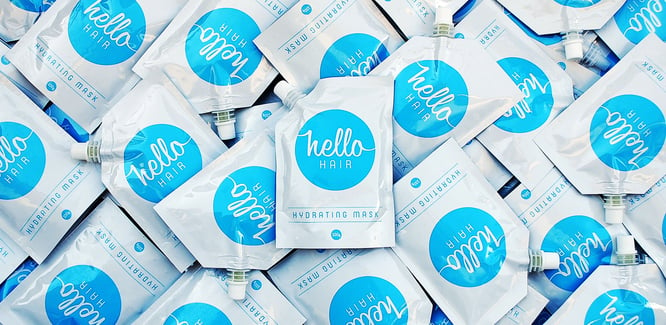Liquids and other viscous materials are notoriously difficult to package.
The risk of spills and wasted product is often greater than solid products, which is why choosing protective packaging is so important for both producers and consumers. For decades, beverage companies have relied on heavy glass or rigid plastic bottles to contain their products, or they have turned to lightweight aluminum cans which can alter the taste of the drink. Cartons and jugs are hefty and often difficult to open, promoting brands to rethink the way they are serving up their beverages to consumers.
Spouted pouches are taking off as one of the most popular solutions for packaging liquids. This lightweight, flexible packaging style better maintains the taste and quality of products, and because there are so many options available to customize stand up pouches for liquids, brands can refresh and innovate to better serve their customers. However, there are several common mistakes liquid product manufacturers must proactively avoid to ensure their packaging is best protecting their drinks and showing off their brand image in its very best light.
Glenroy, Inc. has outlined six obstacles businesses can encounter when making the switch to flexible packaging. We’re diving headfirst into this list to explain how companies can reduce their risk of product or packaging failure and revamp their liquids to maintain their flavor, quality, and overall appearance.
1. Pouch Converting
One of the key reasons to embrace flexible packaging, like spouted pouches, is that it better protects from potential leaks. Whereas glass bottles can shatter, resulting in wasted product, and hard-to-open cartons can easily spill, pouch converting technologies make sure all sides of a stand up pouch are laminated and capable of locking the product in tight. Bottom gussets, side panels, zip locks, and even corners must all be functioning properly, and teaming with a trusted packaging supplier can ensure that happens. 
2. Pouch Prototyping
Not all liquid bags with spout are alike, and without using scientifically developed flexible packaging, you run the risk of stress fractures or sizes that aren’t suitable for your unique product. Your packaging supplier will be able to provide digitally printed prototypes so you can try the packaging out for yourself before you order certain pouches in bulk and realize they just aren't right your unique product. Prototypes will feature your brand’s creative graphics and designs, so you can see exactly what the finished product and packaging will look like to your customers before it even hits store shelves.
3. Filling Equipment
A smart packaging supplier will understand the process of filling a pouch with product and will take this into account when working with you to design the perfect packaging. The filling stage is a key part of the supply chain and can impact the overall look and feel of your spouted pouch. Gaining expert knowledge of the type of equipment used for your bag and how it will impact the overall design of the packaging is key to make sure it best protects your product.
4. Flexible Packaging Materials
As mentioned above, there is no one-size-fits-all solution for packaging your liquids. It’s integral that your company is able to partner with a supplier that can customize and personalize your packaging so each material serves a purpose and benefits your goods. The last thing you want to deal with is product/package compatibility issues, so making sure each structural component makes it easy for your customer to open, close, and transport is key. Because spouted pouches are designed to be user friendly, lightweight, and portable, you’ll have greater success personalizing this type of packaging than rigid bottles and cans that offer little flexibility.
5. Pouch Testing
You’ve designed the perfect pouch and have filled it with your amazing product – great! But how can you be sure it actually functions correctly? Completing various tests is an important way to prevent functionality failures and ensure your package properly performs all the way from the production phase to retail shelves and in users’ homes. Various tests will try out each of the pouch’s features, such as seal functionality, puncture resistance, product/package compatibility, as well as drop testing, burst testing, and compression testing.
6. Spouts and Filaments
Liquid bags with spout are unique because of their external features that allow beverages to be easily poured and consumed. Technology for reclosable spouts is constantly evolving, and your packaging partner should always be supplying the latest innovations. Your spouts should be easy to open, tamper resistant, safe for children, and lend well to controlled pouring without spills or mess. Larger valves are best for thicker viscous liquids, such as gels and condiments, while smaller valves are best for thinner juices and beverages. Your supplier should always make sure your spouted bags suit the unique needs of your product and that each additional feature does not detract or jeopardize the functionality of the bag.

Share this Image On Your Site
(Top Image Source: Dash Creative)
Related Posts:
Stand Up Pouches with Spout: Economical Eco-Friendly Liquid Packaging
Liquid Packaging Just Got Exciting…Even for Regular People
5 Retail Packaging Tips That You Can’t Afford to Ignore
3 Steps to Effective Spouted Stand Up Pouches








